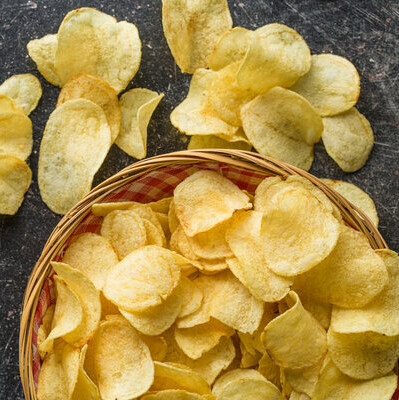
Chips
What are chips?
Chips are snack products which can be made from either cereals or tubers, such as corn or potatoes. Potato chips are perhaps the most famous snack products ever consumed.
Chips can be made using several processing technologies, or their combinations, including:
- Extrusion cooking
- Frying
- Drying
- Extrusion and frying
Origin and history
If we talk about potato chips, a lot can be said about them. The potato is one of the cheapest food raw materials in the world and since it has no decided flavor, it is widely accepted as a “neutral” food ingredient across the globe.
Potato chips date back to 1853 in Saratoga, New York. It seems that a railroad magnate named Commodore Cornelius Vanderbilt was having his dinner at a fashionable hotel in Saratoga Springs, New York. The fried potatoes that were served to him were too thick and he sent them back to the kitchen. Chef George Crum, an Indian American, was put out by the return of his potatoes and he decided to make them paper-thin before he fried them. When presented back to the Commodore, he was pleased and liked the crunchy texture of the new potatoes. The potatoes became a fad in the hotel and in the East but were primarily a restaurant item.1
How are chips made?
Chips are quite straightforward to produce at a commercial scale. Here’s how potato chips are usually made:
- Potato receiving, grading and sorting
- Cleaning, washing and destoning
- Peeling
- Slicing and/or trimming
- Frying (continuous or batch)
- Salting and seasoning
- Cooling
- Serving or packaging
In 1895, William Tappenden of Cleveland, Ohio started making chips for his restaurant clients and the neighborhood stores. His business flourished from the kitchen stove to a converted barn at the rear of his home as the 1st potato chip factory. Soon other family-owned businesses followed this transition.
The potato processing industry quickly flourished and following World War I, there were several chip plants scattered around the U.S. Cleveland, Ohio soon became the center of most of the growing potato chip industry and in 1931 a group formed the Ohio Chip Association and in 1937 they expanded across the country and formed the National Potato Chip Institute, the forerunner to the Snack Food Association of today.
Application
Slicing is the most important operation in a chip plant. Efficiency in slicing produces clean pieces with no feathered edges and no torn slices. These types of slices absorb less oil and do not leave potato pieces in the frying oil to cause it to break down or degrade more quickly.
Quality expectations for chip potatoes
- Light in color (white to light yellow or gold/yellow)
- Round shape
- Minimum of 2’’ in diameter
- High size uniformity (maximum variation of ¾’’)
- Low reducing sugars content (< 0.5 % to limit Maillard browning reactions during frying)
- High dry matter content (total solids content higher than 20%)
- Specific gravity higher than 1.080
- Low percent of peeling waste
- High 8-lb count (ideally higher than 20 and lower than 28)
- Blemish-free
- Excellent texture upon frying
- Mild or “neutral” flavor in the finished (unseasoned) product
References
- History, Who Invented the Potato Chip?, https://www.history.com/news/who-invented-potato-chip-saratoga, Accessed 28 December 2021.

